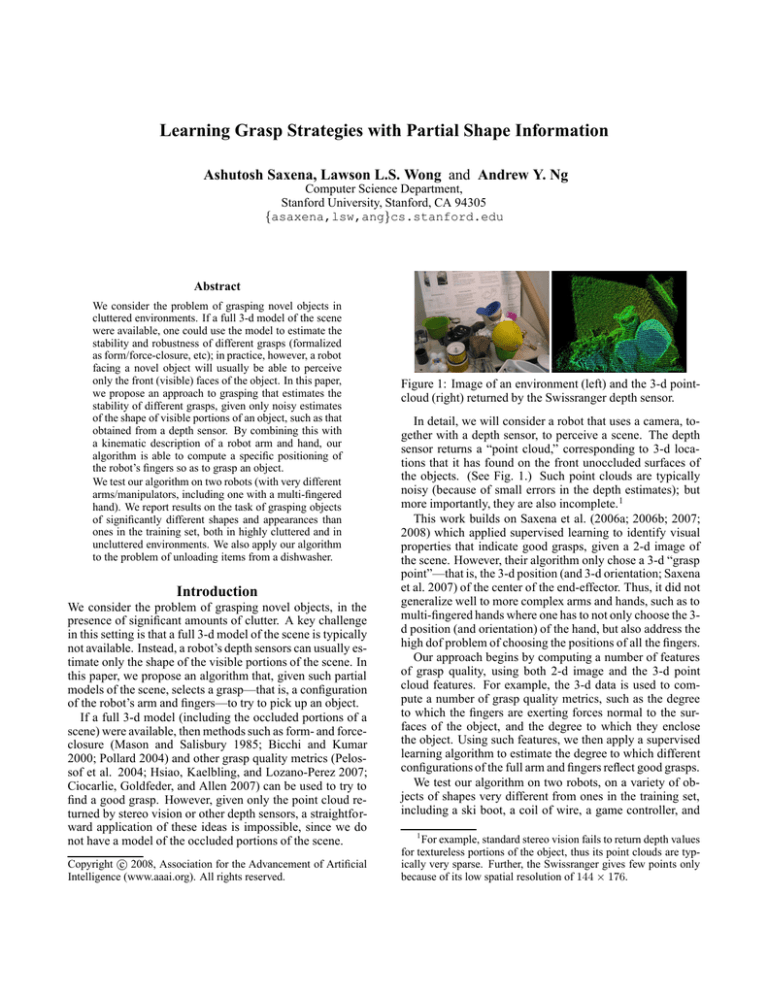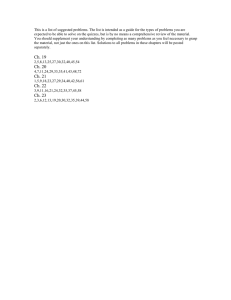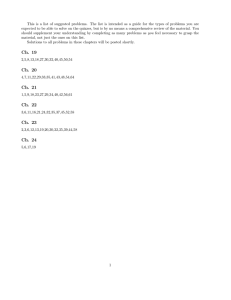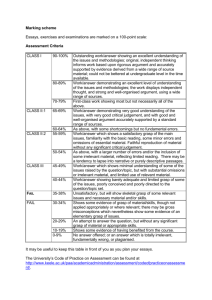
Learning Grasp Strategies with Partial Shape Information
Ashutosh Saxena, Lawson L.S. Wong and Andrew Y. Ng
Computer Science Department,
Stanford University, Stanford, CA 94305
{asaxena,lsw,ang}cs.stanford.edu
Abstract
We consider the problem of grasping novel objects in
cluttered environments. If a full 3-d model of the scene
were available, one could use the model to estimate the
stability and robustness of different grasps (formalized
as form/force-closure, etc); in practice, however, a robot
facing a novel object will usually be able to perceive
only the front (visible) faces of the object. In this paper,
we propose an approach to grasping that estimates the
stability of different grasps, given only noisy estimates
of the shape of visible portions of an object, such as that
obtained from a depth sensor. By combining this with
a kinematic description of a robot arm and hand, our
algorithm is able to compute a specific positioning of
the robot’s fingers so as to grasp an object.
We test our algorithm on two robots (with very different
arms/manipulators, including one with a multi-fingered
hand). We report results on the task of grasping objects
of significantly different shapes and appearances than
ones in the training set, both in highly cluttered and in
uncluttered environments. We also apply our algorithm
to the problem of unloading items from a dishwasher.
Introduction
We consider the problem of grasping novel objects, in the
presence of significant amounts of clutter. A key challenge
in this setting is that a full 3-d model of the scene is typically
not available. Instead, a robot’s depth sensors can usually estimate only the shape of the visible portions of the scene. In
this paper, we propose an algorithm that, given such partial
models of the scene, selects a grasp—that is, a configuration
of the robot’s arm and fingers—to try to pick up an object.
If a full 3-d model (including the occluded portions of a
scene) were available, then methods such as form- and forceclosure (Mason and Salisbury 1985; Bicchi and Kumar
2000; Pollard 2004) and other grasp quality metrics (Pelossof et al. 2004; Hsiao, Kaelbling, and Lozano-Perez 2007;
Ciocarlie, Goldfeder, and Allen 2007) can be used to try to
find a good grasp. However, given only the point cloud returned by stereo vision or other depth sensors, a straightforward application of these ideas is impossible, since we do
not have a model of the occluded portions of the scene.
c 2008, Association for the Advancement of Artificial
Copyright Intelligence (www.aaai.org). All rights reserved.
Figure 1: Image of an environment (left) and the 3-d pointcloud (right) returned by the Swissranger depth sensor.
In detail, we will consider a robot that uses a camera, together with a depth sensor, to perceive a scene. The depth
sensor returns a “point cloud,” corresponding to 3-d locations that it has found on the front unoccluded surfaces of
the objects. (See Fig. 1.) Such point clouds are typically
noisy (because of small errors in the depth estimates); but
more importantly, they are also incomplete. 1
This work builds on Saxena et al. (2006a; 2006b; 2007;
2008) which applied supervised learning to identify visual
properties that indicate good grasps, given a 2-d image of
the scene. However, their algorithm only chose a 3-d “grasp
point”—that is, the 3-d position (and 3-d orientation; Saxena
et al. 2007) of the center of the end-effector. Thus, it did not
generalize well to more complex arms and hands, such as to
multi-fingered hands where one has to not only choose the 3d position (and orientation) of the hand, but also address the
high dof problem of choosing the positions of all the fingers.
Our approach begins by computing a number of features
of grasp quality, using both 2-d image and the 3-d point
cloud features. For example, the 3-d data is used to compute a number of grasp quality metrics, such as the degree
to which the fingers are exerting forces normal to the surfaces of the object, and the degree to which they enclose
the object. Using such features, we then apply a supervised
learning algorithm to estimate the degree to which different
configurations of the full arm and fingers reflect good grasps.
We test our algorithm on two robots, on a variety of objects of shapes very different from ones in the training set,
including a ski boot, a coil of wire, a game controller, and
1
For example, standard stereo vision fails to return depth values
for textureless portions of the object, thus its point clouds are typically very sparse. Further, the Swissranger gives few points only
because of its low spatial resolution of 144 × 176.
Figure 2: (Left) Barrett 3-fingered hand. (Right) Katana parallel plate gripper.
others. Even when the objects are placed amidst significant
clutter, our algorithm often selects successful grasps.
Related Work
Space constraints prevent us from doing full justice to prior
work, and here we will focus on prior work that performed
real-world grasping experiments. For a more detailed treatment of related work, see, e.g., (Mason and Salisbury 1985;
Bicchi and Kumar 2000; Saxena, Driemeyer, and Ng 2008).
In prior work that used vision for real-world grasping
experiments, most were limited to grasping 2-d planar objects. For a uniformly colored planar object lying on a
uniformly colored table top, one can find the 2-d contour
of the object quite reliably. Using local visual features
(based on the 2-d contour) and other properties such as
form- and force-closure, (Coelho, Piater, and Grupen 2001;
Chinellato et al. 2003; Bowers and Lumia 2003; Morales
et al. 2004) computed the 2-d locations at which to place
(two or three) fingertips to grasp the object. In more general
settings (i.e., non-planar grasps), Edsinger and Kemp (2006)
grasped cylindrical objects using a power grasp by using visual servoing and Platt et al. (2006) used schema structured
learning for grasping simple objects (spherical and cylindrical) using power grasps; however, this does not apply
to grasping general shapes (e.g., a cup by its handle) or to
grasping in cluttered environments.
Description of Robots
Our experiments were performed on two robots. STAIR 1
uses a 5-dof harmonic arm (Katana, by Neuronics) with a
parallel plate gripper, and STAIR 2 uses a 7-dof arm (WAM,
by Barrett Technologies) with a three-fingered 4-dof hand.
The robot’s vision system consists of a stereo camera
(Bumblebee2, by Point Grey Research), and a SwissRanger
camera (Swissranger 2005). The SwissRanger camera is a
time-of-flight depth sensor that returns a 144 × 176 array
of depth estimates, spanning a 47.5◦ × 39.6◦ field of view,
with a range of about 8m. Using an infrared structured light
source, each pixel in the camera independently measures the
arrival time of the light reflected back by the objects. Its
depth estimates are typically accurate to about 2cm. However, it also suffers from systematic errors, in that it tends
not to return depth estimates for dark objects, nor for surfaces lying at a large angle relative to the camera’s image
plane. (See Fig. 1 for a sample 3-d scan.)
Grasping Strategy
There are many different properties that make certain grasps
preferable to others. Examples of such properties include
form- and force-closure (to minimize slippage), sufficient
contact with the object, distance to obstacles (to increase robustness of the grasp), and distance between the center of
the object and the grasping point (to increase stability). In
real world grasping, however, such properties are difficult to
compute exactly, because of the quality of sensor data. Our
algorithm will first compute a variety of features that attempt
to capture some of these properties. Using these features,
we then apply supervised learning to predict whether or not
a given arm/finger configuration reflects a good grasp.
Definition of grasp: We will infer the full goal configuration of the arm/fingers that is required to grasp an object. For
example, STAIR 1 uses an arm with 5 joints and a parallel
plate gripper (with one degree of freedom); for this robot,
the configuration is given by α ∈ R6 . The second robot
STAIR 2 uses an arm with 7 joints, equipped with a threefingered hand that has 4 joints (Fig. 2); for this robot, our
algorithm infers a configuration α ∈ R11 . We will informally refer to this goal configuration as a “grasp.”
We will then use a motion planner algorithm (Saha and
Isto 2006) to plan a path (one that avoids obstacles) from the
initial configuration to this goal configuration.
Probabilistic Model
We will use both the point-cloud R and the image I taken of
a scene to infer a goal configuration α of the arm/fingers.
Saxena et al. (2006a) classified each 2-d point in a given
image as a 1 (candidate grasp) or 0. For example, for an image of a mug, it would try to classify the handle and rim as
candidate grasping points. In our approach, we use a similar
classifier that computes a set of image features and predicts
the probability P (y = 1|α, I) ∈ [0, 1] of each point in the
image being a candidate grasping point. However, a remaining difficulty is that this algorithm does not take into account
the arm/finger kinematics; thus, many of the 2-d points it selects are physically impossible for the robot to reach.
To address this problem, we use a second classifier that,
given a configuration α and a point-cloud R, predicts the
probability P (y|α, R) that the grasp will succeed. This classifier will compute features that capture a variety of properties that are indicative of grasp quality. Our model will
combine these two classifiers to estimate the probability
P (y|α, R, I) of a grasp α succeeding. Let y ∈ {0, 1} indicate whether {α, R, I} is a good grasp. We then have:
P (y|α, R, I) ∝ P (R, I|y, α)P (y, α)
(1)
We assume conditional independence of R and I, and uniform priors P (α), P (I), P (R) and P (y). Hence,
P (y|α, R, I) ∝ P (R|y, α)P (I|y, α)P (y, α)
∝ P (y|α, R)P (y|α, I)
(2)
Here, the P (y|α, I) is the 2-d image classifier term similar to the one in Saxena et al. (2006a).
We also use
P (y|α, R; θ) = 1/ exp 1 + ψ(R, α)T θ , where ψ(R, α)
are the features discussed in the next section.
Inference: From Eq. 2, the inference problem is:
α∗ = arg max log P (y = 1|α, R, I)
α
= arg max log P (y = 1|α, R) + log P (y = 1|α, I)
α
Now, we note that a configuration α has a very small chance
of being the optimal configuration if either one of the two
terms is very small. Thus, for efficiency, we implemented an
image-based classifier P (y|I, α) that returns only a small set
of 3-d points with a high value. We use this to restrict the set
of configurations α to only those in which the hand-center
lies on one of the 3-d location output by the image-based
classifier. Given one such 3-d location, finding a full configuration α for it now requires solving only an n − 3 dimensional problem (where n = 6 or 11, depending on the
arm). Further, we found that it was sufficient to consider
only a few locations of the fingers, which further reduces
the search space; e.g., in the goal configuration, the gap between the finger and the object is unlikely to be larger than
a certain value. By sampling randomly from this space of
“likely” configurations (similar to sampling in PRMs) and
evaluating the grasp quality only of these samples, we obtain an inference algorithm that is computationally tractable
and that also typically obtains good grasps.
Features
Below, we describe the features that make up the feature
vector ψ(R, α) used to estimate a good grasp. The same
features were used for both robots.
Presence / Contact: For a given finger configuration, some
part of an object should be inside the volume enclosed by
the fingers. Intuitively, more enclosed points indicate that
the grasp contains larger parts of the object, which generally
decreases the difficulty of grasping it (less likely to miss).
For example, for a coil of wire, it is better to grasp a bundle
rather than a single wire. To robustly capture this, we calculate a number of features—the number of points contained
in spheres of different sizes located at the hand’s center, and
also the number of points located inside the volume enclosed
within the finger-tips and the palm of the hand.
Symmetry / Center of Mass: Even if many points are enclosed by the hand, their distribution is also important. For
example, a stick should be grasped at the middle instead of
at the tip, as slippage might occur in the latter case due to a
greater torque induced by gravity. To capture this property,
we calculate a number of features based on the distribution
of points around the hand’s center along an axis perpendicular to the line joining the fingers. To ensure grasp stability,
an even distribution (1:1 ratio) of points on both sides of the
axis is desirable. More formally, if there are N points on
one side and N ′ on the other side, then our feature would be
|N − N ′ |/(N + N ′ ). Again, to increase robustness, we use
several counting methods, such as counting all the points,
and counting only those points not enclosed by the hand.
Local Planarity / Force-Closure: One needs to ensure a
few properties to avoid slippage, such as a force closure on
the object (e.g., to pick up a long tube, a grasp that lines up
the fingers along the major axis of the tube would likely fail).
Further, a grasp in which the finger direction (i.e., direction
in which the finger closes) is perpendicular to the local tangent plane is more desirable, because it is more likely to lie
within the friction cone, and hence is less likely to slip. For
Figure 3: Snapshots of our robot grasping novel objects of
various sizes/shapes.
example, when grasping a plate, it is more desirable that the
fingers close in a direction perpendicular to the plate surface.
To capture such properties, we start with calculating the
principal directions of a 3-d point cloud centered at the point
in question. This gives three orthonormal component directions ui , with u1 being the component with largest variance,
followed by u2 and u3 . (Let σi be the corresponding variances.) For a point on the rim of a circular plate, u1 and
u2 would lie in the plane in which the plate lies, with u1
usually tangent to the edge, and u2 facing inwards. Ideally,
the finger direction should be orthogonal to large variance
directions and parallel to the small variance ones. For fj as
the finger direction (j = 1 for parallel gripper, and j = 1, 2
for three-fingered hand), we would calculate the following
features: (a) Directional similarity, sij = |ui · fj |, and (b)
−σi
Difference from ideal, ( σσ11−σ
− sij )2 .
3
Experiments
We performed three sets of extensive experiments: grasping
with our three-fingered 7-dof arm in uncluttered as well as
cluttered environments, and on our 5-dof arm with a parallel
plate gripper for unloading items in a cluttered dishwasher.
Grasping single novel objects
We considered several objects from 13 novel object classes
in a total of 150 experiments. These object classes varied
greatly in shape, size, and appearance, and are very different
from the plates, bowls, and rectangular blocks used in the
training set. During the experiments, objects were placed at
a random location in front of our robot. Table 1 shows the results: “Prediction” refers to the percentage of cases the final
grasp and plan were good, and “Grasp success” is the percentage of cases in which the robot predicted a good grasp
and actually picked up the object as well (i.e., if the object
slipped and was not picked up, then it counted as failure).
Using the same robot, Saxena et al. (2007) considered
power grasps only and required that objects be neatly placed
on a “rack.” However, we consider the significantly harder
task of grasping randomly placed objects in any orientation.
Further, many objects such as ski boots, helmets, etc. require more intricate grasps (such as inserting a finger in the
ski boot because it is too big to hold as a power grasp).
For each object class, we performed 10-20 trials, with
Table 1: STAIR 2. Grasping single objects. (150 trials.)
O BJECT C LASS
BALL
A PPLE
G AMEPAD
CD CONTAINER
H ELMET
SKI BOOT
PLATE BUNDLE
B OX
ROBOT ARM LINK
C ARDBOARD TUBE
FOAM
STYROFOAM
C OIL OF WIRE
SIZE
SMALL
SMALL
SMALL
SMALL
MED
MED
MED
MED
MED
LARGE
LARGE
LARGE
LARGE
PREDICTION
80%
90%
85%
70%
100%
80%
100%
90%
90%
70%
60%
80%
70%
G RASP SUCCESS
80%
80%
80%
60%
100%
80%
80%
90%
80%
65%
60%
70%
70%
different instances of each object for each class (e.g., different plates for “plates” class). The average “Prediction”
accuracy was 81.3%; and the actual grasp success rate was
76%. The success rate was different depending on the size of
the object.2 Both prediction and actual grasping were best
for medium sizes, with success rates of 92% and 86% respectively. Even though handicapped with a significantly
harder experimental trial (i.e., objects not neatly stacked,
but thrown in random places and a larger variation of object sizes/shapes considered) as compared to Saxena et al.,
our algorithm surpasses their success rate by 6%.
Grasping in cluttered scenarios
In this case, in addition to the difficulty in perception, manipulation and planning became significantly harder in that
the arm had to avoid all other objects while reaching for the
predicted grasp; this significantly reduced the number of feasible candidates and increased the difficulty of the task.
In each trial, more than five objects were placed in random
locations (even where objects touched each other, see some
examples in Fig. 3). Using only the 2-d image-based method
of Saxena et al. (with PRM motion planning), but not our
algorithm that considers finding all arm/finger joints from
partial 3-d data, success was below 5%. In a total of 40
experiments, our success rate was 75% (see Table 2). We
believe our robot is the first one to be able to automatically
grasp objects, of types never seen before, placed randomly
in such heavily cluttered environments.
Table 2: STAIR 2. Grasping in cluttered scenes. (40 trials.)
E NVIRONMENT
T ERRAIN
T ERRAIN
K ITCHEN
K ITCHEN
O BJECT
T UBE
ROCK
PLATE
B OWL
PREDICTION
87.5%
100%
87.5%
75%
G RASP SUCCESS
75%
75%
75%
75%
Table 3: STAIR 1. Dishwasher unloading results. (50 trials.)
O BJECT C LASS
PLATE
B OWL
M UG
2
PREDICTION G OOD
100%
80%
80%
ACTUAL SUCCESS
85%
75%
60%
We defined an object to be small if it could be enclosed within
the robot hand, medium if it was approximately 1.5-3 times the size
of the hand, and large otherwise (some objects were even 4ft long).
Applying algorithm on a different robotic platform
One of the properties of the algorithm is that it is agnostic to particular robot platforms. We applied our algorithm
on STAIR 1, and attempted to grasp kitchen items from a
cluttered dishwasher with the presence of 3 or more objects
placed randomly (see Table 3). In a total of 50 experiments,
even with more clutter than in Saxena et al. (2006a; 2007)
(where objects were placed neatly in dishwasher), our algorithm gave comparable results. Our algorithm is therefore
generalizable to different robots.
We have made our grasping movies available at:
http://stair.stanford.edu/multimedia.php
References
Bicchi, A., and Kumar, V. 2000. Robotic grasping and contact: a
review. In ICRA.
Bowers, D., and Lumia, R. 2003. Manipulation of unmodeled
objects using intelligent grasping schemes. IEEE Trans Fuzzy
Systems 11(3).
Chinellato, E.; Fisher, R. B.; Morales, A.; and del Pobil, A. P.
2003. Ranking planar grasp configurations for a three-finger
hand. In ICRA.
Ciocarlie, M.; Goldfeder, C.; and Allen, P. 2007. Dimensionality
reduction for hand-independent dexterous robotic grasping. In
IROS.
Coelho, J.; Piater, J.; and Grupen, R. 2001. Developing haptic
and visual perceptual categories for reaching and grasping with a
humanoid robot. Robotics and Autonomous Systems 37:195–218.
Edsinger, A., and Kemp, C. 2006. Manipulation in human environments. In Int’l Conf Humanoid Robotics.
Hsiao, K.; Kaelbling, L.; and Lozano-Perez, T. 2007. Grasping
POMDPs. In ICRA.
Mason, M., and Salisbury, J. 1985. Robot Hands and the Mechanics of Manipulation. MIT Press, Cambridge, MA.
Morales, A.; Chinellato, E.; Sanz, P. J.; del Pobil, A. P.; and Fagg,
A. H. 2004. Learning to predict grasp reliability for a multifinger
robot hand by using visual features. In Int’l Conf AI Soft Comp.
Pelossof, R.; Miller, A.; Allen, P.; and Jebara, T. 2004. An svm
learning approach to robotic grasping. In ICRA.
Platt; Grupen; and Fagg. 2006. Improving grasp skills using
schema structured learning. In ICDL.
Pollard, N. S. 2004. Closure and quality equivalence for efficient
synthesis of grasps from examples. IJRR 23(6).
Saha, M., and Isto, P. 2006. Motion planning for robotic manipulation of deformable linear objects. In ICRA.
Saxena, A.; Driemeyer, J.; Kearns, J.; and Ng, A. Y. 2006a.
Robotic grasping of novel objects. In NIPS.
Saxena, A.; Driemeyer, J.; Kearns, J.; Osondu, C.; and Ng, A. Y.
2006b. Learning to grasp novel objects using vision. In ISER.
Saxena, A.; Wong, L.; Quigley, M.; and Ng, A. Y. 2007. A
vision-based system for grasping novel objects in cluttered environments. In ISRR.
Saxena, A.; Driemeyer, J.; and Ng, A. Y. 2007. Learning 3-d
object orientation from images. In NIPS workshop on Robotic
Challenges for Machine Learning.
Saxena, A.; Driemeyer, J.; and Ng, A. Y. 2008. Robotic grasping
of novel objects using vision. IJRR 27(2):157–173.
Swissranger. 2005. Mesa imaging. In http://www.mesaimaging.ch.






